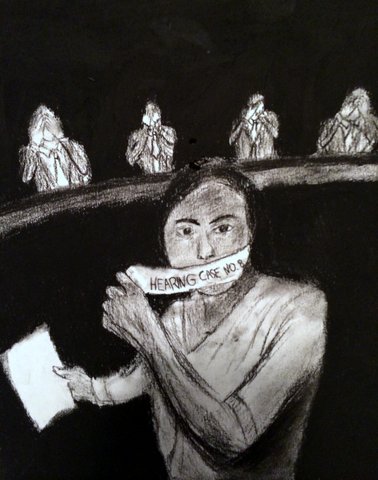 Illustration of a person with 'CASE 8' written across their mouth and a panel of people with their hands over their eyes
Illustration of a person with 'CASE 8' written across their mouth and a panel of people with their hands over their eyes
Columbia Students’ Fight Against Campus Sexual Violence— And For Administrative Transparency
When universities cover up the extent of campus sexual violence, they marginalize the true gravity of the issue and those fighting back.
By George Joseph
Society’s historically racist template for what sexual violence looks like generally confines itself to the dark city alley in which a Black male stranger overpowers a young white girl. But for college students the reality is much closer to home. 57% of rapes occur on a date, 90% of college women know their rapist, and one in four college women have survived rape or attempted rape. In fact, according to a US Department of Justice policeguide, “College women are more at risk for rape and other forms of sexual assault than women the same age but not in college.” Furthermore, studies have shown that the fraternity experience makes men more likely to rape, and fraternity members committhree times more sexual assaults than non-fraternity members. In other words, at college, rapists and the culture that supports them are an integral part of campus. Yet nationwide, university administrations have not only refused to tackle this reality head on, but have actually done everything to cover it up, thereby isolating survivors and marginalizing those insisting on the severity of the situation. Because of this reprehensible state of affairs, in October the Columbia University Democrats released apetition, demanding the university release anonymous aggregate data on campus rape and its consequences; yet after two months of op-eds, meetings, and negotiations, the administration has continued to hide the numbers and with them the chillingly proximate nature of rape on our campus.
Such refusals to bring about transparency mask the extent to which rape haunts campus life and administrative complicity in the process, but unfortunately are not limited to Columbia. Earlier this year at Princeton, for example, a 2008 administrative survey finding that one in six Princeton female undergraduates had experienced “non-consensual vaginal penetration” was kept secret for five years until it was leaked to the press. In response to the controversial leak, Amada Sandoval, Director of Princeton’s Woman’s Center, explained, “a story that Princeton’s rates of students who have been assaulted is on line with national averages is really not a story,” noting there was no “real benefit” to the release and that “people would make a big deal about it.” But this story, common to every university, is never actually heard. As one survivor at Columbia explained, “The school has sat down with the Dems, but there hasn’t been any real action taken… The first and most major problem is the silencing of the victim because as long as we are silenced this crime can happen continuously and whether or not the school punishes them, survivors won’t ever feel safe enough to speak up for themselves.”
When administrators like Sandoval hold back the true extent of sexual violence on campus, they help perpetuate our enduring cultural stereotypes of what rape looks like, thereby undermining our ability to call out sexual violence on campus for what it is and blinding us from the immense danger within. “Most girl’s [experience with assaults] are singular cases, they never hear about anything else, the idea of going through it alone is just too overwhelming, so there’s no desire to push forward with it,” the survivor said, “because they feel like, ‘no one’s going to believe me, most rapes are a stranger or something jumping out of a bush.’ I realized this was a really big problem and if I didn’t do something about it my rapist was going to continue to get away with this because its so overlooked by society.”
At Columbia University, after robberies or intrusions occur in nearby parks or neighborhoods, the public safety department diligently emails the student body with photos of the alleged assailants, which do absolutely nothing to stop such incidents from happening and invariably conform to our cultural assumptions about what “criminals” look like. Yet the vast majority of violent criminals go unnoticed. They sit in our classrooms, eat at our lunch tables, and go to our parties. The terrifying reality is that they are our friends; they are us. As one survivor declared, “People don’t really understand the nuances of what campus rape means, I’ve lost a lot of friends, who are so insensitive to the issue, because they really can’t wrap their mind around the fact that a rape by a friend is just as bad, and perhaps even worse, then being raped by a stranger.” As long as universities refuse to release these numbers, we will be unable to conceive of and condemn the true extent of sexual violence within our community, the first step in our struggle to end it.
The campus Democrats’ petition, in contrast to the robbery reports, does not ask for anything personally explicit so as not to compromise the identities of survivors. Administrative compliance with the petition would release information regarding: what portion of assailants are found responsible, what guidelines are followed to determine types of punishment, how often punishments are lessened or repealed, and the average length of time required to investigate and adjudicate a case. If Columbia was actually doing its job, why would there be any hesitation to release this anonymous data? As one survivor explained, “I’m so angry about it because there’s obviously no reason except their failure,” noting even when the assault hearing panel suspended one of her friend’s rapists for a mere semester, she kept seeing him on campus. “Their occasional ‘punishments’ are not even serious,” she concluded, adding, “at this point the administration must know that the fact that they are not releasing the numbers is proof enough of their complicity.”
Melissa Rooker, Columbia’s Title IX Coordinator and Section 504 Compliance Officer,refused to offer her personal opinion on the release of aggregate data regarding sexual assault and its consequences, despite her position as chair of the advisory committee looking into the issue, vaguely saying, “I think if you think a little bit harder there are other ways that we can be transparent in what this process is.” Even more disturbingly, when questioned about a recent New York Post story reporting on a Columbia athlete that remained on campus despite having been accused of raping two female students and groping another, Rooker callously stated, “I would encourage you not to believe everything you read,” a response which underscores the remarkably condescending attitude of the administration to those that come forward, yet another silencing mechanism.
In response to this dismissal, one of the survivors involved in the case said, “a lot of people don’t realize how much work and energy and tears we had to expend just to have our voices heard anonymously in the paper… there’s a reason that only a few voices are ever heard like that . I’m sure there are so many people at Columbia, whose voices will never be heard. The fact that the administration is so dismissive of us is really frustrating.” Another survivor from the case echoed these sentiments, noting, “It just shows the university views the survivor and not the rapist as the liability. Her comments are trying to reinforce the idea that the administration is the only voice that you can trust and that is patently false.”
Furthermore, in regard to the New York Post story, Rooker assured us that those students found responsible for rape “may have requirements,” including a severe “maybe having to write something.” In our meeting, Rooker declared, “In order to come to come back, you may have to have meeting with the Dean of Students. They’re gonna want to know, what have you been doing for your two years? What’s going on? What do you look like now? Is this someone we want to welcome back into the community?” These astonishingly insignificant restitution measures seem like a slap on the wrist in comparison to the dire warnings we receive for nonviolent crimes like academic plagiarism and drug usage, but apparently are often not even enforced, another reason the university has still not released the statistics. According to one of the survivors involved in the same case, “My rapist didn’t have a single requirement, if she said that to assure you, that’s certainly not true.” She went on to explain how though the athlete had been found guilty, he appealed the decision, making the process impossible to continue for another survivor who had already graduated. “Because she physically did not have any more time to do this, our rapist got off without any punishments at all. His most severe punishment for assaulting six Columbia students would have been disciplinary hearing and he even escaped that, he even didn’t have to write something.”
Judging by the conduct of Columbia thus far, it is obvious that the administration will do as much as it can to delay and water down student efforts to bring about transparency and accountability. Unfortunately, neither sexual violence nor the administration’s complicity in it are limited to Columbia. In response to universities’ refusals to come clean about the issue, students across the country are beginning to organize to force through accountability. As the New York Times recently reported, students from Occidental and UNC to Amherst and Yale are sharing strategies on how to deal with such systematic administrative failures, using social media to make survivor’s voices heard nationally and in some cases even mobilizing to press civil rights charges against universities blocking transparency, utilizing Title IX’s protection against sex-based discrimination, which in April 2011 the US Department of Education’s Civil Rights Officedefinitively stated included protection against sexual violence. One survivor at Columbia mused on the possibilities of this growing movement, saying, “I’m glad there’s a conversation that’s been started on our campus. All this action came at a good time and there’s a collective voice. I think this could hopefully have a domino effect, one campus will show what is possible for the next.”
When universities hide the true extent to which sexual violence afflicts campus, they isolate the voices of those that have survived such attacks and undermine our ability as a community to recognize the severity of the situation. This refusal reinforces our narrow and racialized perception of rape, in the process adding to our disgraceful inability to resolutely condemn rape regardless of the perpetrator. It is the responsibility of the university to broaden our vision and make us more sensitive to the chilling reality that rape, and the culture that perpetuates it, is a significant part of campus life. Releasing the numbers is the first step in this process, but if our administrators continue to remain complicit, covering up the true extent of campus rape, students must go it alone, shaming them every step of the way. As one survivor declared, “Whether they release the numbers or not, its going to be because of student initiative, not going because of people on some committee. If we make enough noise around campus and in the media, they will be forced to change.”
George Joseph
George Joseph is a labor and education reporter, who looks to The Wire and Toblerones for daily inspiration.
Catch up with me @GeorgeJoseph94.

